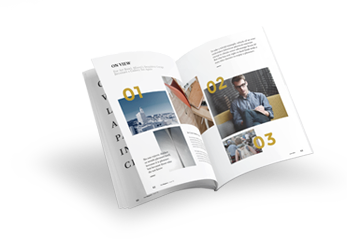Mouna Rebeiz sweeps into the Saatchi Gallery, her long coat flapping in the slipstream of her arrival, carrying two or three bags and a dinner jacket – something she describes as a ‘smok-ing’.
Everything about Mouna is dramatic: tall and statuesque as be-fits an erstwhile model; coal black eyes which shine all the more brightly in contrast to her pale skin; her striking features framed by a shock of wavy black hair which in others would seem un-ruly, but which seems to fit perfectly with her restless character. In short, Mouna Rebeiz would be the ideal subject for one of her own paintings.
In a sense, the exhibition of paintings recently on show at the Saatchi Gallery is ‘the statement that isn’t’. One might think that a collection of nudes wearing nothing but the tardasche or Fez, traditionally worn in some countries in the Middle East as a symbol of male dominance, carries a feminist message. Mouna is adamant: “ I am not a feminist. I hate politics. Politics is all bullshit – its just money and power!”
This is a bold statementat a time when the Middle East is being increasingly radicalised as never before. Lebanon, her country of origin, is sixty percent muslim, but Mouna is unfazed. “His-bollah? Who are these people? I do not know them! In Lebanon we are free – like Europe”. Nevertheless, even moderate Muslim culture finds it hard to accept the frenetic sexualisation of west-ern culture, where the female form is shamelessly exploited to move product.
In contrast to this, the graceful lines and subtle skin tones of the figures in Mouna Rebeiz’ paintings seem to recall Kenneth Clark’s description of the nude in art: “The word nude…carries, in educated usage, no uncomfortable overtone. The vague image it projects into the mind is not of a huddled, defenceless body, but a prosperous and confident body”.
This is in line with the training Mouna has received. Originally a student of psychology at the Sorbonne, she then trained for ten years under Alix de la Source, an expert in 17th and 18th century art at the Louvre and the Musee d’Orsay. Originally influenced by French painters like Watteau and Bouchard, Mouna was later drawn to the more sensual work of Rubens. So where does Mouna Rebeiz stand in the debates that rage about gender and equality? Her answers are thoughtful if a little com-
plicated. :” In Lebanon the place of women is changing in many ways. (So) it has never been more important to reflect at length on the very essence of the ‘woman being’. I am Levantine, Leba-nese…Lebanese women are at once sensual and sophisticated. I also identify as French, and a characteristic of French feminity is precisely that sophistication. … At a time when many magasines seek to reduce women, photoshopped and thin, I choose to paint them fleshy, timeless, women as mistress and mother, women both sensual and maternal”
The fez was the instrument chosen to make her point. “I decided to take an object that, in its cultural and historical context, was essentially a male article of clothing, in counterpoint… This is not a provocation. This not about any opposition between man and woman. It is not an act of militancy. To put a tarbouche on the head of a naked woman is to recall the place of woman in the world. I have hijacked the tarbouche and made it an emblem of feminity”.
After London, there are plans to take the exhibition of paintings, first to Paris , and then to New York.





